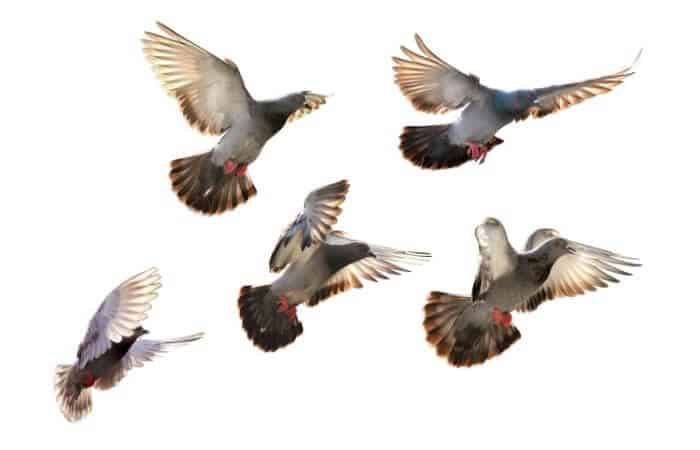We all know about the homing pigeon and its ability to unerringly return home to its loft from distances up to six hundred or more miles away.
What we don’t know is how they do it. These birds seem to have an innate ability. This has piqued the curiosity of many scientists and has thrown up different theories.
Researchers have made many studies and tests, but the question still remains unanswered.
There are educated guesses, but no concrete proof of any of them. Animal navigation, at least where it concerns pigeons, is still hotly disputed.
The various theories about pigeon navigation include:
- Magnetoreception
- Compass and map
- Olfactory navigation
- Visual navigation
- Infrasound
1. Magnetoreception

Magnetoreception is the use of magnetic fields to find direction.
Magnetic fields are electric currents or pulses that emitted from the earth’s core.
Pigeons, it seems, are very sensitive to magnetic fields and use them to orient themselves.
There isn’t any actual explanation as to how this really works.
One theory put forward is that pigeons have iron particles embedded in the top of their beaks, which aligns them with the Polar North, also called dead reckoning. However this theory was disproved in 2012.
2. Compass and map

This method is by way of using the sun as a principle guide and then using remembered landmarks such as rivers, roads, or mountains as supplementary guides.
When pigeons take flight they circle first. This is believed so that they can orientate themselves with the sun.
Once they have the direction of the sun fixed, they can use familiar landmarks to guide them where they want to go and they use the same method on their return journey.
That doesn’t explain how homing pigeons can be taken hundreds of miles away from familiar surroundings in closed baskets, either by car or train and then are released to find their way home without fail.
3. Olfactory navigation

This is the theory that pigeons can identify smells and with that they can find their direction.
The earth’s surface gives off certain odours depending on the composition of the soil, clay, fauna, and terrain.
Supposedly, pigeons are very sensitive to these odours and can catalogue them to use as pathfinders.
In fact, there are two olfactory theories.
One states that pigeons can use this map of distinct environment odours to within a 70-100 mile radius.
The other states that pigeons can use this same method, over much longer distances.
The two are called ‘mosaic model’ and ‘gradient model ‘respectively. These windblown scents can be perceived over and miles and miles.
Which answers the question of enclosed homing pigeons being taken to a release point.
They smell the different scents and their changes on their way to the release point and simply backtrack.
The gradient theory says these odours have different intensities over distance and that pigeons can compare them to gain a directional pointer.
Unfortunately, neither of these two theories have come up with any conclusive proof.
Added to that, there’s debate over whether or not environmental odours really do exist.
4. Visual navigation

Visual navigation is quite simply a memorised topographical map of the terrain and landmarks that pigeons fly over.
Pigeons, the same as other animals, always know the direction in which the sun lies or can orient themselves easily enough even on cloudy days.
With that information as an anchor point, they can then follow the contours of the land.
They use these natural landmarks such as coastlines, rivers, hills and mountains.
They can also use man-made structures as guidelines, such as cities, roads, railway lines, and bridges too.
Although pigeons sleep and don’t fly at night, during the transition hours of dawn and dusk, when the stars are still visible, they can use celestial navigate to aid them as well.
5. Infrasound

Infrasound navigation is similar to sonar in which sound can give direction and distance.
Acoustic and seismic energy are generated by the earth and the oceans in constant waves.
This theory suggests that pigeons are sensitive to very low frequency sounds too low for the human ear to detect.
Pigeons have been found to have sensitive fibres within their inner ears that can detect these ultra-low frequencies.
Infrasound gives directional cues and builds sound maps for the birds to follow.
These also help them to sense air turbulences from very long distances.
Again, nobody knows exactly how it works for pigeons and is one of the lesser touted theories of pigeon navigation.
Conclusion
It can be said that nobody knows for sure how pigeons navigate.
All these theories and methods have been researched and tested, but not one has proved to be a definite answer to the question of how do pigeons manage to navigate such long distances without becoming lost.
Until such an answer can be empirically proven, we are left with the theories, but it would be wise to conclude that the pigeon’s natural navigational ability may well be a mixture of all the different methods already mentioned.
There is nothing to say that this isn’t the case.
Why do scientists insist that there should only be one way that pigeons can navigate, when they have the ability to use all of them?
